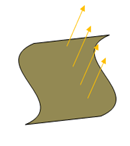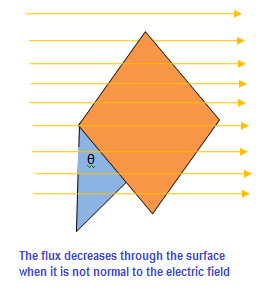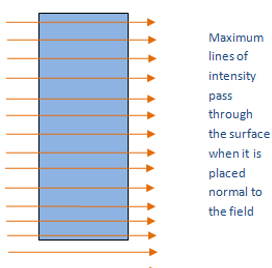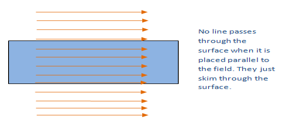Question 3: Explain the concept of electric flux. Using mathematical representations of electric flux to show that how electric flux is maximum and minimum.
ANSWER
Electric Flux definition
Electric flux is the number of electric field lines passing through a surface placed in the electric field. It is denoted by φ.
Mathematically,
Where E = Electric field intensity
A= Area placed in the field, and
θ = Angle between and .

From the above equation, unit of flux can be easily calculated. It is Nm2C-1.
As an example, 4 electric field lines are passing through the surface in the above figure. Therefore, flux through this area is 4 Nm2C-1.
More cases
(1) When the area A vector is making an angle other than 0° with the field lines, then


See in the figure below that (Acosθ) is parallel to E.

(2) We take the case of electric flux through closed surface. When the surface is closed or curved, we divide it into small elements of area which can be considered flat for practical purposes. Let ΔA1, ΔA2, ΔA3… ΔAn is the small elements of areas on the surface which are practically flat. The flux through the surface is the sum of all the fluxes through the elements of area.

(Note: The same argument can be applied in case when the flux is non-uniform. When we divide the surface into small patches, then the flux through any such small surface is practically uniform.)
Maximum Electric Flux
Electric flux depends upon E , A and the angle between them. However, if E and A are constant, then θ determines whether the flux to be more or less. If θ = 0°, cosθ = 1 which is the maximum value of cosθ. In such a case the surface area is placed perpendicular to the electric lines of force. See the figure.

Minimum Electric Flux

When θ is 90° cosθ = 0, the flux through the area is minimum (=0). In such a case the area is placed parallel to the electric field lines as shown in the figure. No force lines pass through the surface.

Pingback:gauss-law-and-its-applications – msa
Pingback:electric-field-and-intensity – msa
Pingback:index-ch11-p12